#pycnodontiformes
Explore tagged Tumblr posts
Text
Coccodus
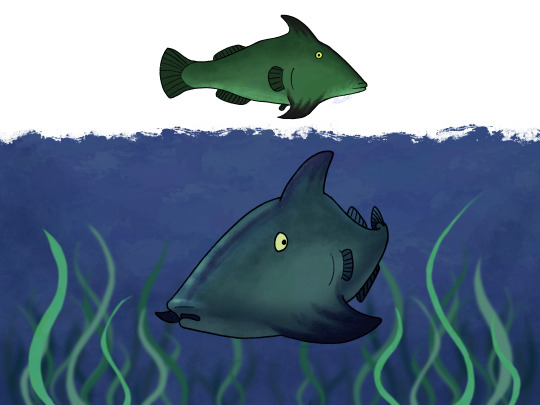
Coccodus was a genus of coccodontid fish from the Late Cretaceous Period. Its type species is C. armatus. Its second known species is C. insignis. C. armatus and C. insignis were found in the Hakel and Hajula Formations in Lebanon, respectively. Unlike most other pycnodontiform fish, which often had a short body, Coccodus has a relatively long body and somewhat resemble the distantly related chimaeras.
C. insignis was differentiated from the type species by its broader lateral spines and relatively short but anteroposteriorly broad occipital spine. A third species, "C." lindstroemi, was named alongside C. insignis, however, the assigned specimens were found to actually belong to the new species of Joinvillichthys lindstroemi, J. kriweti, and Pankowskichthys libanicus.
C. armatus is known from its holotype, which consists of most of the front half of its body. Notably, two large, curved spines are present where pectoral fins would be expected. C. insignis is very similar in shape, but is known from several different skeletons. The greater family Coccodontidae sits within Pycnodontiformes, an extinct order of bony fish. It also has two related families, Gladiopycnodontidae and Gebrayelichthyidae, with which it forms the superfamily Coccodontoidea.
Original papers: C. armatus, C. insignis, C. lindstroemi reassignment
Wikipedia article: Coccodus
#bony fish#ray finned fish#paleoart#paleontology#artwork#original art#human artist#coccodus#coccodontidae#pycnodontiformes#actinopterygii#osteichthyes#obscure fossil animals#obscure fossil fish#obscure fossil tetrapods
3 notes
·
View notes
Text











Many people are not aware of the many incredible fish deep time has to offer, dinosaurs just take up so much media space!
Rhinconichthys, Dentilepisosteus
Tartuosteus, Brindabellaspis
Tselfatia, Alienacanthus
Aleosteus, Martillichthys
Polymerichthys, Foreyia
But most importantly never forget Pycnodontiforms!




Stenoprotome, Gladiopycnodus
Maraldichthys, Monocerichthys
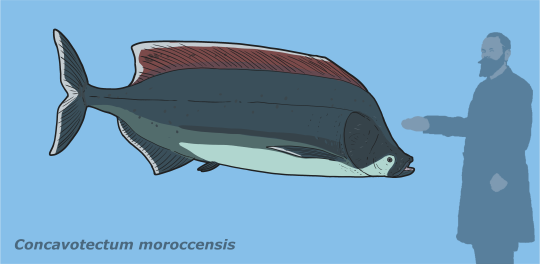
Spinosaurus drama is cool and things, but do you know what's even cooler? Better fossils of animals that lived with Spinosaurus!
There is a new specimen of Concavotectum currently on display in Tuscon. BigSkyFossils took some photos of it and I had to doodle it! It's been a while since I did a tselfatiform and now we have finally an idea how the postcranium looked like!
So far we only had a few fragments and this pretty good skull. As some people noted though, the eye is reconstructed in the wrong corner.

4K notes
·
View notes
Text
okay i have done enough intensive research for tonight. i will leave these ugly bastards alone until tomorrow...

#theyre SO UGLY!!!!!!!!#wip#pycnodontid#pycnodontiformes#pycnodontidae#bony fish#fish#prehistoric fish#paleoart#coccodus#fossil fish#art#sketch#raine art
0 notes
Photo

Pycnodont Fish Teeth Palate Fossil | Jurassic Oxfordian | Oxfordshire UK | Authentic Fossil with COA | Alice Purnell Collection
Pycnodont Fish Teeth Palate Fossil | Jurassic Oxfordian | Oxfordshire, UK
Uncover a fascinating piece of prehistoric marine life with this Pycnodont Fish Teeth Palate Fossil from the Oxfordian Stage of the Jurassic Period, expertly preserved and sourced from Oxfordshire, UK. This genuine specimen, part of the renowned Alice Purnell Collection—home to one of the largest ammonite collections globally—offers a rare opportunity to own a piece of Earth’s ancient history.
Geology & Fossil Information:
Species: Pycnodont Fish (Order: Pycnodontiformes)
Fossil Type: Teeth Palate
Geological Period: Jurassic (Oxfordian Stage, ~163.5 - 157.3 million years ago)
Location Found: Oxfordshire, United Kingdom
Pycnodont fish were prominent during the Mesozoic Era, recognized for their distinctive, flat crushing teeth, perfect for feeding on hard-shelled organisms like mollusks and crustaceans. This fossilized teeth palate is a captivating example of their unique dentition and ecological role.
Key Features:
100% Genuine Fossil Specimen
Includes a Certificate of Authenticity
From the prestigious Alice Purnell Collection
Actual specimen shown – Scale rule squares/cube = 1cm (full sizing available in the photo)
This meticulously selected fossil makes an excellent addition for collectors, educators, and enthusiasts of paleontology and natural history. The accompanying photograph displays the exact specimen you will receive, ensuring complete transparency and authenticity.
Add this rare Jurassic fossil to your collection today and own a piece of ancient marine history!
#Pycnodont Fish Fossil#Jurassic Fish Fossil#Oxfordian Fossil#Pycnodont Teeth Palate#Oxfordshire Fossil#UK Fossils#Genuine Fossil#Fossil with Certificate#Alice Purnell Collection#Authentic Jurassic Fossil#Paleontology Collectible#Fossil Collector Item#Natural History Fossil#Fossil Fish Teeth#Jurassic Era Fossil#UK Paleontology#Rare Fossil Specimen
0 notes
Text
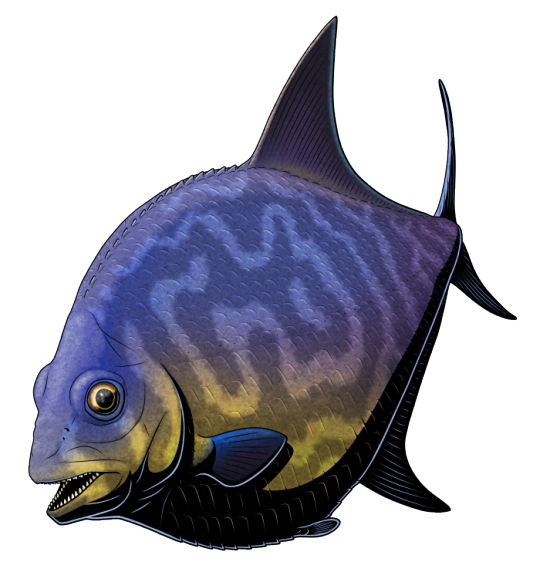
The pycnodonts were a diverse group of ray-finned fish that were found in shallow coastal waters from the late Triassic to the late Eocene (~215-37 million years ago). They usually had deep but very narrow body shapes with a disc-like appearance, convergently similar to modern reef fish like marine angelfish or butterflyfish – but some looked much weirder, with elaborate horns and spines, long snouts, or vertically-stretched bodies.
Most of them also had jaws full of round flat teeth used to crush hard-shelled prey, but some may instead have been herbivorous grazers similar to parrotfish.
And a couple of lineages even became carnivores.
Serrasalmimus secans lived in what is now Morocco during the late Paleocene, about 59 million years ago. Although only known from its jaws, the size of the fossil material suggests it was fairly large for a pycnodont, possibly around 80cm long (~2'8").
It had sharp flesh-cutting teeth similar to those of modern piranha, but with a surprising evolutionary twist. Unlike any other known ray-finned fish, Serrasalmimus' teeth were true shearing carnassials anchored into bony sockets, with new replacement teeth forming directly below each current tooth – a very specific arrangement of features previously only known in mammals.
This is an especially remarkable example of convergent evolution because on land placental carnivorans were developing their own carnassials at the same time, just a few million years after the K-Pg mass extinction. Both mammals and pycnodonts were simultaneously taking advantage of the vacant predatory roles in their respective ecosystems, and ended up with incredibly similar tooth adaptations as a result.
———
Nix Illustration | Tumblr | Twitter | Patreon
#science illustration#paleontology#paleoart#palaeoblr#serrasalmimus#serrasalmimidae#pycnodonts#pycnodontiformes#neopterygii#actinopterygii#fish#art#convergent evolution#swim like a butterflyfish bite like a mammal
243 notes
·
View notes
Text
We are SO sleeping on how weird prehistoric fishes are. Like our legged fish ancestors or armored placoderms like Dunkleosteus are weird in their own way but they have nothing on them
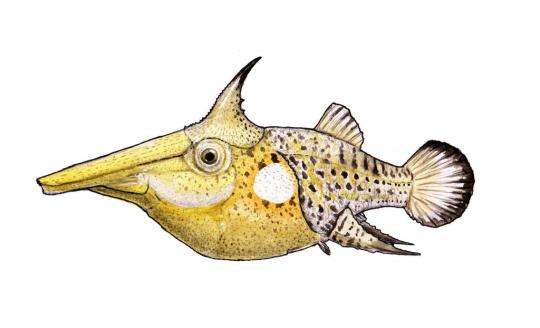
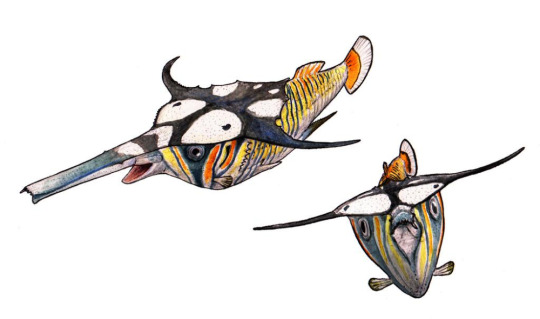
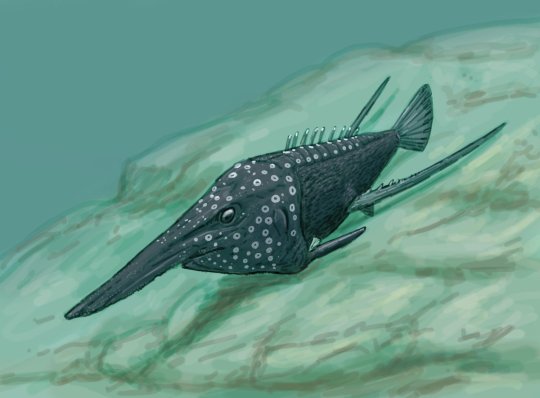
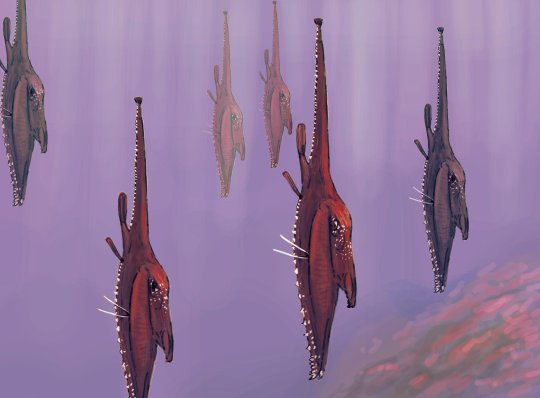
Pycnodonts: literally any body shape they want that uncanny valley except some genera that look like normal trevallies
(Rostropycnodus, Stenoprotome, Gladiopycnodus, Maraldichthys by Joshua Knüppe)

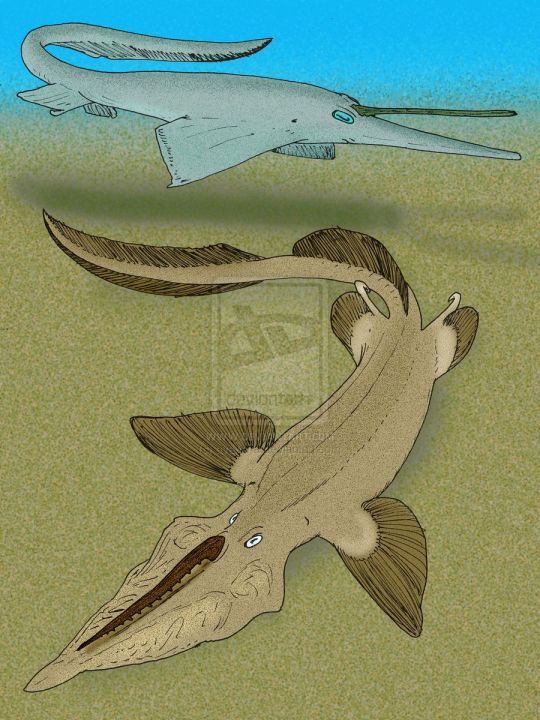
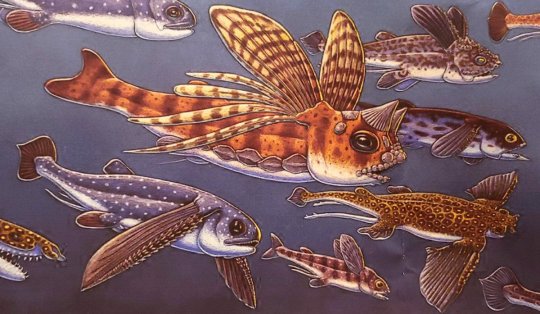
Holocephali: cartiliginous fish closely related to chimaeras, which means they are relatives to sharks.
(Traquairius agkistrocephalus, Belantsea, and Squaloraja by Stanton F. Fink, Iniopterygidae by Ray Troll)
#fish#palaeoblr#palaeoart#joshua knüppe#ray troll#stanton f. fink#pycnodonts#pycnodontiformes#fossil#palaeontology#prehistoric animals#dinosaur#weird animals#holocephali#shark
12K notes
·
View notes
Text
Descubren el pez con aletas de raya y dentición más antiguo conocido hasta la actualidad
Descubren el pez con aletas de raya y dentición más antiguo conocido hasta la actualidad
Un nuevo descubrimiento científico tiene conmocionada la comunidad científica internacional, se ha encontrado el pez con aletas de raya y dentición más antiguo conocido hasta la actualidad; un pez cuyo aspecto es muy parecido al de las pirañas actuales de la región amazónica, aunque este vivió en los arrecifes coralinos de los mares antiguos durante el Triásico superior y el Eoceno.
El…
View On WordPress
0 notes
Photo

Pycnodont Fish Teeth Palate Fossil | Jurassic Oxfordian | Oxfordshire UK | Genuine Fossil with COA | Alice Purnell Collection
Discover a remarkable piece of paleontological history with this Pycnodont Fish Teeth Palate Fossil from the Oxfordian Stage of the Jurassic Period, sourced from Oxfordshire, UK. This authentic specimen, part of the prestigious Alice Purnell Collection—renowned for being one of the largest ammonite collections globally—offers a rare glimpse into ancient marine ecosystems.
Geology & Fossil Information:
Species: Pycnodont Fish (Family: Pycnodontiformes)
Fossil Type: Teeth Palate
Geological Period: Jurassic (Oxfordian Stage, ~163.5 - 157.3 million years ago)
Location Found: Oxfordshire, United Kingdom
Pycnodont fish thrived in shallow marine environments during the Mesozoic Era. Known for their flat, crushing teeth, they fed primarily on hard-shelled prey like mollusks and crustaceans. This fossilized palate highlights the unique dentition of the species, making it an excellent addition to any fossil or paleontology collection.
Key Features:
100% Genuine Fossil Specimen
Includes a Certificate of Authenticity
From the Alice Purnell Collection, a world-renowned fossil collection
Actual specimen as pictured – Scale rule squares/cube = 1cm (full sizing in photos)
This carefully chosen fossil is perfect for collectors, educators, or anyone passionate about natural history. The provided photo showcases the exact specimen you will receive, ensuring transparency and quality.
Add a piece of prehistoric life to your collection today!
#ycnodont Fish Fossil#Jurassic Fish Fossil#Oxfordian Fossil#Pycnodont Teeth Palate#UK Fossils#Oxfordshire Fossils#Genuine Fossil#Fossil with Certificate#Alice Purnell Collection#Authentic Jurassic Fossil#Paleontology Collectible#Fossil Collector Item#Natural History Fossil#Fossil Fish Teeth#Jurassic Era Fossil#UK Paleontology#Rare Fossil Specimen
0 notes
Text
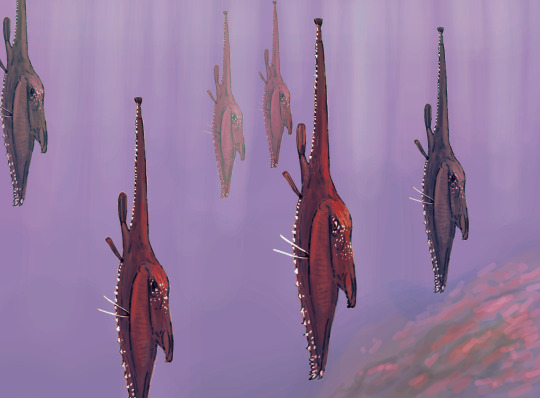
Another sketch brought to you by #paleostream
"DON'T BE AFRAID, the swarm said as it hovered closer. Barely as fish recognizable bodies moving up and down in the current.
Maraldichthys, a pycnodontiform fish and one of the strangest vertebrates the world has ever seen.
3K notes
·
View notes
Photo
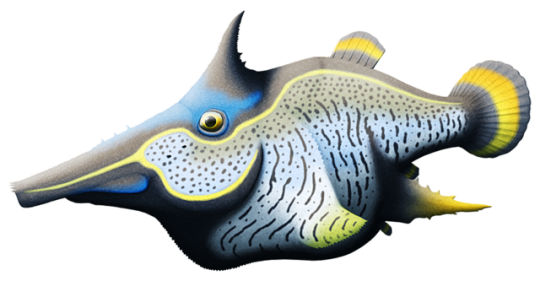
The extinct pycnodonts were a group of mostly circular-shaped fish, convergently similar to modern reef fish like marine angelfish or butterflyfish -- but some of them developed much much weirder appearances.
Rostropycnodus gayeti here was one of the especially odd-looking forms, known from the mid-Cretaceous of Lebanon about 100-95 million years ago.
It had an elongated snout with the upper jaw longer than the lower, a pointed spiky horn on its forehead, and a massive pectoral region that bulged out at the front of its body. Meanwhile its pectoral fins were modified into big immobile spines, and its pelvic fins were highly reduced and positioned beneath another set of large spines.
And it was tiny, only about 5.5cm long ~(2″).
It would have been a slow swimmer, relying on its spikiness to deter larger predators, and it’s currently unclear what it ate with its unusual spiny snout. Many other pycnodonts had mouths full of round crushing teeth, but Rostropycnodus’ jaws seem to have been mostly toothless -- so perhaps it used its snout to probe around in cracks or sediment for small soft-bodied invertebrates.
---------
Tumblr | Pillowfort | Twitter | Patreon
#science illustration#paleontology#paleoart#palaeoblr#rostropycnodus#gladiopycnodontidae#pycnodonts#pycnodontiformes#neopterygii#actinopterygii#fish#art#snootfish#that is an excellent snoot#i just want a tank full of weird little pycnodonts
170 notes
·
View notes
Note
hi, i have a very important question. which pycnodont is "butterfly but uncanny valley"? (i'm pretty good with modern fish, but i'm new to paleo-fish)
Ah I was referring to Eomesodon. But anyways I'm not really that versed in prehistoric fish and kinda amateurish at modern fish as I do self research mostly so omg I really aspire to have that much passion anon.
1 note
·
View note
Photo
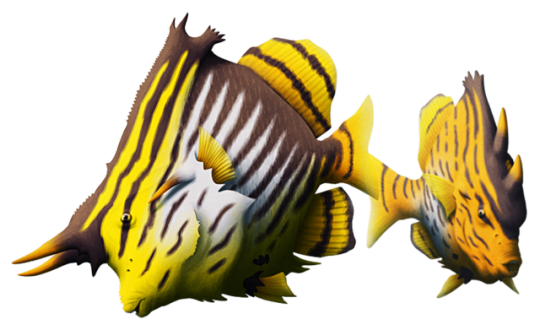
Almost-Living Fossils Month #06 -- Circle Fish
Pycnodonts were a group of fish that originated in the western Tethys Sea during the Late Triassic (~215 mya), and later spread to most of the rest of the world with the exception of Antarctica and Australia. Ranging in size from a few centimeters to around 2m (6′6″), they had deep vertically-flattened bodies and almost circular silhouettes. Although they somewhat resembled modern marine angelfish or butterflyfish, they weren’t actually very closely related, instead being part of a much older branch of neopterygian fish.
They inhabited a range of shallow coastal waters from marine to freshwater environments, and most of them had jaws full of round flat teeth used to crush hard-shelled prey -- but some may have been herbivorous grazers similar to parrotfish, and one lineage even became sharp-toothed piranha-like predators.
Some also developed quite elaborate appearances, such as Hensodon spinosus here. Living during the peak of the pycnodonts’ diversity in the mid-to-late Cretaceous, its fossils are known from Lebanon and date to about 100-95 million years ago.
It was only about 7cm long (2.75″) but it was bristling with various small spines and large “horns”, with different specimens showing two distinct arrangements. One type had double-pronged forward-facing horns, while the other had two horns one after the other -- this may be evidence of sexual dimorphism, with the “bull horned” form thought to be male and the “rhino horned” form thought to be female.
Hensodon was also probably stripy in life, since one fossil preserves faint evidence of a light-and-dark stripe pattern on its dorsal fin.
Only a few pycnodonts survived into the Cenozoic, and their last appearance in the fossil record was in the mid-Eocene (~40 mya). Since this was at about the same time that more modern types of reef fish began to evolve, it’s likely that a combination of new competition and changing climate conditions resulted in the last pycnodonts going extinct by the end of the Eocene around 33 million years ago.
#almost living fossils month#science illustration#paleontology#paleoart#palaeoblr#pycnodonts#pycnodontiformes#hensodon#coccodontidae#neopterygii#actinopterygii#fish#art#convergent evolution#lov the cronch
189 notes
·
View notes
Text
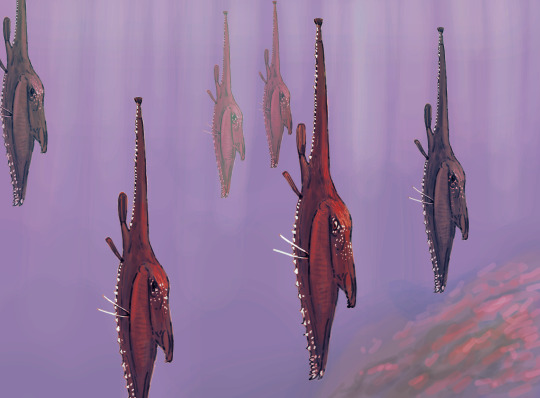
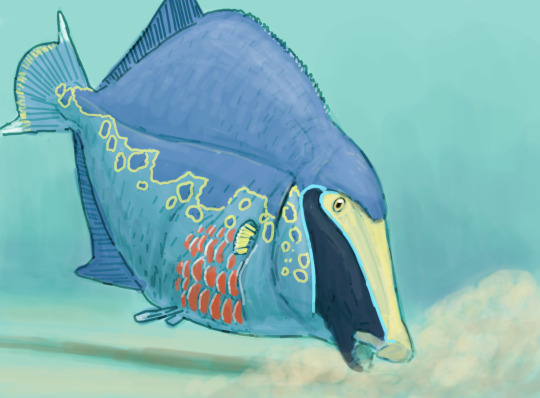


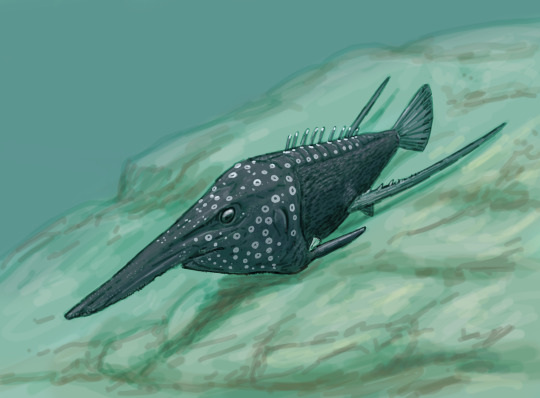
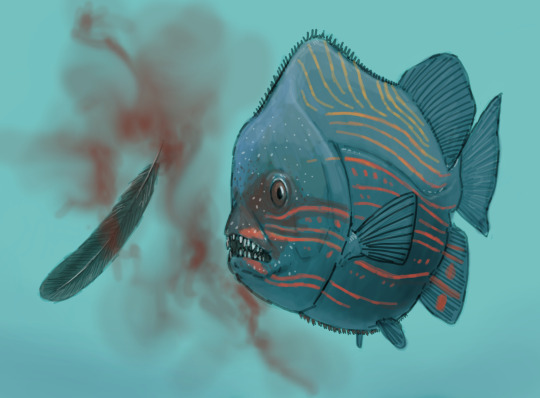
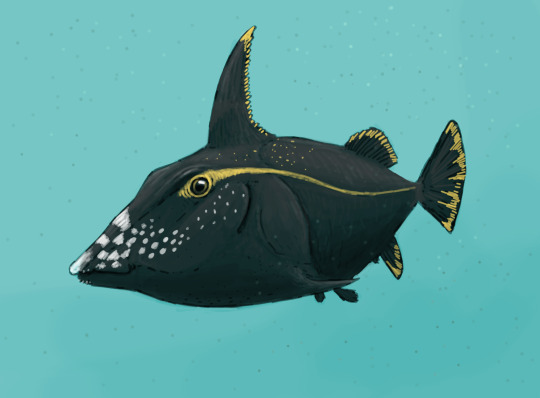
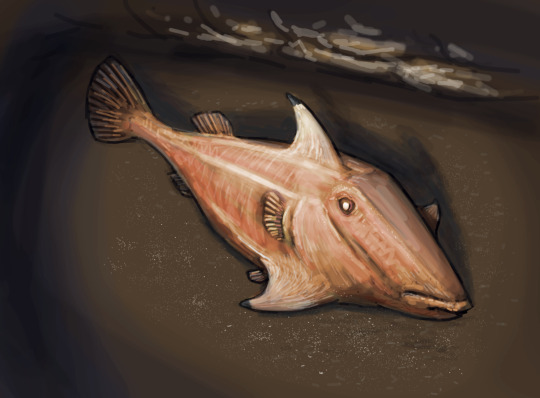
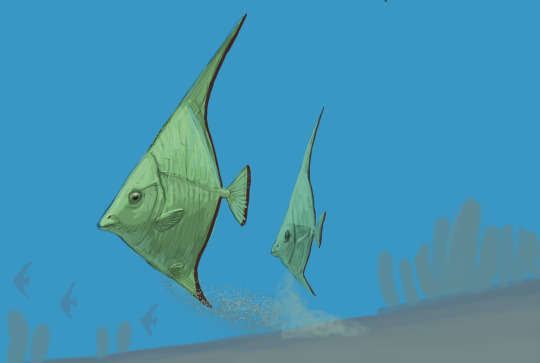
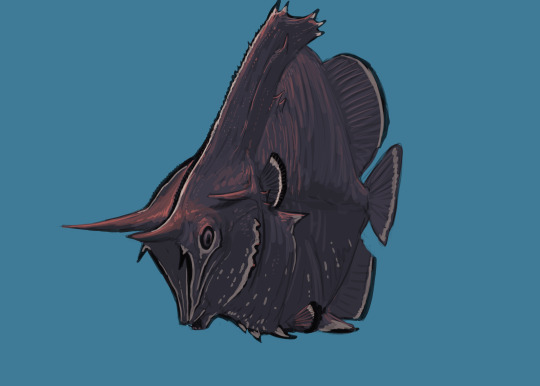
I posted Maraldichthys before, but pycnodontiformes have other, bizarre shapes to offer. Here some of them
Maraldichthys
Rhinopycnodus, Stenoprotome, Brembodus,
Gladiopycnodus,
Piranhamesodon, Monocerichthys, Coccodus,
Flagellipinna, Hensodon.
2K notes
·
View notes
Text

Maybe you have a typo in there? But oh yes it's real, there are just few people who dare to reconstruct it. Also look up it's sister taxon Gebrayelichthys (here my restoration)

Another sketch brought to you by #paleostream
"DON'T BE AFRAID, the swarm said as it hovered closer. Barely as fish recognizable bodies moving up and down in the current.
Maraldichthys, a pycnodontiform fish and one of the strangest vertebrates the world has ever seen.
3K notes
·
View notes
Text
And this is why I like fish so much.

Another sketch brought to you by #paleostream
"DON'T BE AFRAID, the swarm said as it hovered closer. Barely as fish recognizable bodies moving up and down in the current.
Maraldichthys, a pycnodontiform fish and one of the strangest vertebrates the world has ever seen.
3K notes
·
View notes